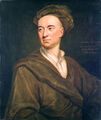Template:Selected anniversaries/April 29: Difference between revisions
No edit summary |
No edit summary |
||
| Line 10: | Line 10: | ||
||1833 – William Babington, Anglo-Irish physician and mineralogist (b. 1756) | ||1833 – William Babington, Anglo-Irish physician and mineralogist (b. 1756) | ||
||William Edward Story (b. April 29, 1850) was an American mathematician | |||
File:Henri Poincaré.jpg|link=Henri Poincaré (nonfiction)|1854: Mathematician, physicist, and engineer [[Henri Poincaré (nonfiction)|Henri Poincaré]] born. He will make many original fundamental contributions to pure and applied mathematics, mathematical physics, and celestial mechanics. | File:Henri Poincaré.jpg|link=Henri Poincaré (nonfiction)|1854: Mathematician, physicist, and engineer [[Henri Poincaré (nonfiction)|Henri Poincaré]] born. He will make many original fundamental contributions to pure and applied mathematics, mathematical physics, and celestial mechanics. | ||
Revision as of 21:08, 27 November 2017
1667: Physician, satirist, and polymath John Arbuthnot born. He will invent the figure of John Bull.
1756: Inventor, astronomer, mathematician, clockmaker, and surveyor David Rittenhouse constructs an exceptionally accurate orrery, which he will later use to create an early form of time crystals (nonfiction).
1854: Mathematician, physicist, and engineer Henri Poincaré born. He will make many original fundamental contributions to pure and applied mathematics, mathematical physics, and celestial mechanics.
1974: Watergate scandal: United States President Richard Nixon announces the release of edited transcripts of White House tape recordings relating to the scandal.
1985: Asclepius Myrmidon discovers unregistered halting problem, predicts imminent wave of crimes against mathematical constants.
1986: Chernobyl disaster: American and European spy satellites capture the ruins of the 4th Reactor at the Chernobyl Power Plant.





